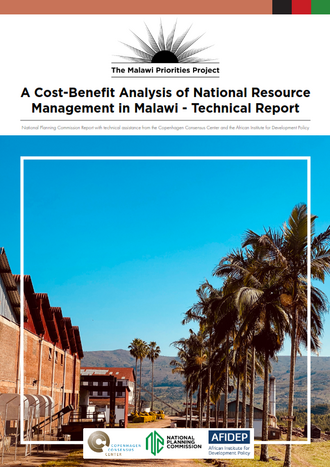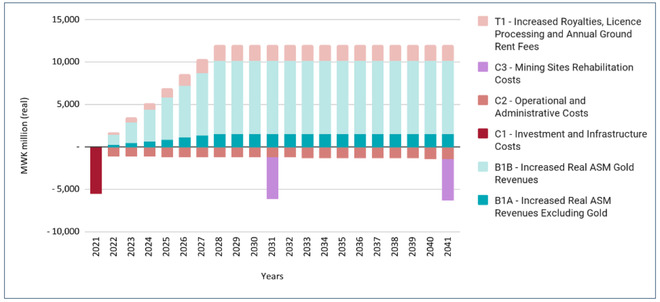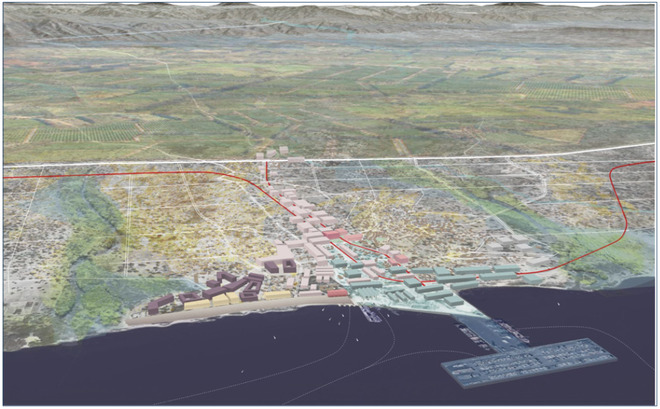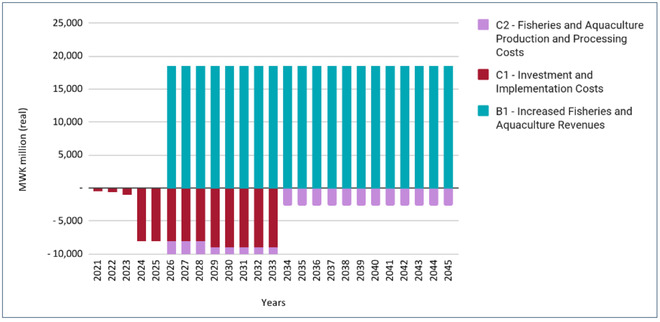Malawi Priorities: National Resource Management
Technical Report
Key Messages
 Despite being endowed with substantial minerals, gemstones, and water bodies, Malawi’s mining and fisheries sectors have been unable to fully take advantage of these resources for wealth creation. Both sectors face similar barriers to generating more wealth for the country: informality, lack of sophisticated practices and value-addition, and limited linkages to trade markets.
Despite being endowed with substantial minerals, gemstones, and water bodies, Malawi’s mining and fisheries sectors have been unable to fully take advantage of these resources for wealth creation. Both sectors face similar barriers to generating more wealth for the country: informality, lack of sophisticated practices and value-addition, and limited linkages to trade markets.- The analysis highlights two large-scale projects that could increase the value generated by mining and fisheries: Artisanal and small-scale mining ‘landing centers’; and the Chipoka Port Fisheries Project. These projects would contribute towards Malawi’s wealth creation and industrialization goals, for example improving the share of mining from 0.8% of GDP in 2020 to 10% in 2030 and increasing the value-addition from forestry, livestock, fishing from MWK 406,000 million to MWK 600,000 million by 2030.
- Twelve artisanal and small-scale mining ‘landing centers’ would formalize and support the 20-40,000 miners across the country, providing financial and technical support, propagating information on best practices and appropriate technologies, and ensuring compliance with laws and regulations, particularly concerning health, safety, child labor, and environmental protection. The intervention will require MWK 5,353 million in upfront investments for infrastructure and machinery, with ongoing costs around MWK 1,200 to MWK 1,300 million per year. In 2031 and 2041 MWK 4,911 million is required for the rehabilitation of mined land to mitigate environmental impacts. This investment is expected to boost gemstone and gold ASM mining revenues by 35% equivalent to MWK 10,165 million per year by 2028. The intervention could also generate benefits worth MWK 625 million in terms of avoided injury, improved sanitation at mine sites, and avoided child labor. For every 1 kwacha invested, this program would yield 3.6 kwacha in benefits, which is relatively high for interventions that generate economic benefits. This intervention could be a foundational piece to support additional wealth creation investments in the ASM sector.
- The Chipola Port Fisheries project is a large-scale infrastructure program that aims to boost the quantity and quality of fish products provided by the country. The intervention involves aquaculture farms and processing facilities to add value to fish caught in Lake Malawi. The annual investment and implementation cost rise from MWK 401 million in 2021 to MWK 8,023 million by 2024. Additional investment in production and processing costs would emerge in 2026, at an annual MWK 2,716 million. The investment is expected to boost revenues from fisheries and aquaculture by MWK 18,495 million per year. For every 1 kwacha invested, this program would yield 1.9 kwacha in benefit.
Context
Malawi’s arable land, forests, woodlands, and water and mineral resources are vital for livelihood, food and nutritional security, economic development, and wealth creation. Malawi's terrain boasts a variety of mineral resources, including gemstones and ornamental stones, industrial minerals, construction mineral materials, and coal, as well as diverse mineral resources include gold, uranium, bauxite, heavy mineral sands, rare earth, niobium, tantalite, copper, nickel, iron ore. Its water resources are also plentiful, with Lake Malawi housing between 700 to 1,000 fish species alone. As a national resource, these bodies of water contribute to the country's wealth creation via fisheries, irrigation, electricity generation, and tourism. Artisanal and small-scale operations in the extractive and fisheries/aquaculture sectors are crucial to income generation and poverty reduction, particularly in rural low-income communities.
At present, both sectors are vulnerable to informality, illegal trade, weak institutional capacity, and limited and ineffective monitoring. These barriers constrain the sectors' potential to contribute significantly to Malawi's wealth creation despite its national resource abundance. The cost-benefit analysis quantifies the impacts of a subset of interventions that will improve the regulation, value-addition, marketing, and wealth creation in both sectors.
Intervention 1: Artisanal and Small-Scale Mining Landing Centers
Malawi is endowed with a variety of mineral resources. However, the sector is largely unregulated, and the production, processing, and marketing procedures of the value chain performed by the ASM operators are rudimentary. Additional challenges within the sector include informal and scattered production practices; lack of knowledge and practices of value-addition; deficiency of critical human capital and expertise, e.g., gemologist; lack of capital to mechanize the exploration and extraction processes; limited or no access to international markets; export of minerals in rough form, generating meager foreign exchange earnings; and, adverse health, safety, child labor, and environmental externalities.
This leads to significant economic and social losses for the country. The selected intervention targets the ASM district landing centers to accumulate these unorganized and inefficient operations and provide formalization, licensing, mechanization, exploration, value addition, training, and marketing support to the Malawian
ASM subsector. In detail, the intervention consists of the following components;
- Building 12 landing centers in various districts,
- Building 3 regional headquarters for the control and administration of the landing centers,
- Building mineral libraries and laboratories in each regional headquarter,
- Building an international marketing center,
- Providing ASM operators with exploration, digging, and value-addition equipment and machinery,
- Providing capacity building to local miners on each operation step,
- Sending representatives to international exhibitions for promoting Malawi's processed minerals.
Costs and Benefits of ASM Landing Centers
The intervention is expected to cost MWK 5,353 million in upfront investments for infrastructure and machinery, with ongoing operational and administrative costs around MWK 1,200 to MWK 1,300 million per year. In 2031 and 2041, MWK 4,911 million is required for the rehabilitation of mined land to mitigate environmental impacts.
This investment is expected to boost gemstone and gold ASM mining revenues by 35% equivalent to MWK 10,165 million per year by 2028. This arises from a combination of improved production efficiency, expanding into new mineral reserves, and increased value addition to extracted resources. The intervention could also generate benefits worth MWK 625 million in terms of avoided injury, improved sanitation at mine sites, and avoided child labor, though the research team was not able to quantify this benefit precisely due to a lack of data. For every 1 kwacha invested, this program would yield 3.6 kwacha in benefits, which is relatively high for interventions that generate economic benefits. The primary beneficiaries of the intervention are the ASM miners.
These benefits are only the direct impacts of the intervention and do not include potential flow-on effects. Implementation of this intervention would transform the ASM subsector into a modern medium-scale one. The formalized and modernized subsector could generate more revenues for the operators, create employment opportunities for the youth, and increase Malawi's foreign exchange earnings from value-added mining exports. It is also reasonable for the intervention to improve Malawi's mining sector's attractiveness for foreign direct investments, generating further wealth creation investments.
Intervention 2: The Chipoka Port Fisheries and Aquaculture Infrastructure and Land Development Project
Fishing contributes substantially to the livelihoods and food security of Malawians. Aquaculture in Malawi, both pond-based and cage farming, has the great economic potential to be the main driver of sustained fish supply to match the increased protein needs of the population as fish catches dwindle under capture fisheries. However, its ability to contribute to Malawi’s wealth creation and respond to the nation’s protein needs is impeded by informality, lack of sophisticated practices and value-addition, and limited linkages to trade markets.
Figure 1: Mining - Cash Flow Over Time

The Chipoka Port Fisheries and Aquaculture Infrastructure and Land Development Project focus on developing a sector-wide national hub for industrial, commercial, and logistical activities, linking to related vital sectors such as tourism, transportation, agriculture, and urban development. To achieve this, the project targets the infrastructure and functional port area to provide the sector with boat docking and repair, fish storage, processing, packaging facilities, and models for smaller fish farms.
Figure 2: Chipoka Port Fisheries Project Proposed Design

Figure 3: Fisheries - Cash Flow Over Time

Costs and Benefits of the Intervention
The intervention requires substantial upfront investment and implementation costs requiring MWK 87,700 million spread out over 13 years to 2033. Operating and processing costs begin in 2026 and are estimated at MWK 2,716 million per year. The intervention is expected to generate value addition worth MWK 18,495 million from 2026 onwards. This is derived from MWK 6,975 million from the processing of fish, MWK 1,800 million from industrial processing, and MWK 9,720 million from aquaculture.
Summary Table
| Intervention | BCR | Costs | Benefits |
|---|---|---|---|
| Formalization and Modernization of the ASM Sub-sector by District Landing Centers | 3.6 Fair | MWK 5,353 million upfront investment in infrastructure and machinery MWK 1,200 to MWK 1,300 million per year ongoing costs. MWK 4,900 million for land rehabilitation in 2031 and 2041 |
MWK 10,165 million per year in increased gold and gemstone revenues MWK 625 million per year in avoided poor sanitation, injury and child labor benefits (uncertain) |
| Chipoka Port Fisheries and Aquaculture Infrastructure and Land Development Program | 1.9 Fair | MWK 87,700 million in upfront infrastructure and implementation costs MWK 2,760 million per year in ongoing processing costs |
MWK 18,945 million per year in increased fish value addition |
Note: BCRs are based on costs and benefits discounted at 8% (see accompanying technical report). BCR ratings are determined on the following scale Excellent, BCR > 15; Good, BCR 5-15; Fair, BCR 1-5; Poor, BCR < 1. This traffic light scale was developed by an Eminent Panel including several Nobel Laureate economists for a previous Copenhagen Consensus project that assessed the Sustainable Development Goals.
Download the full policy brief here.

